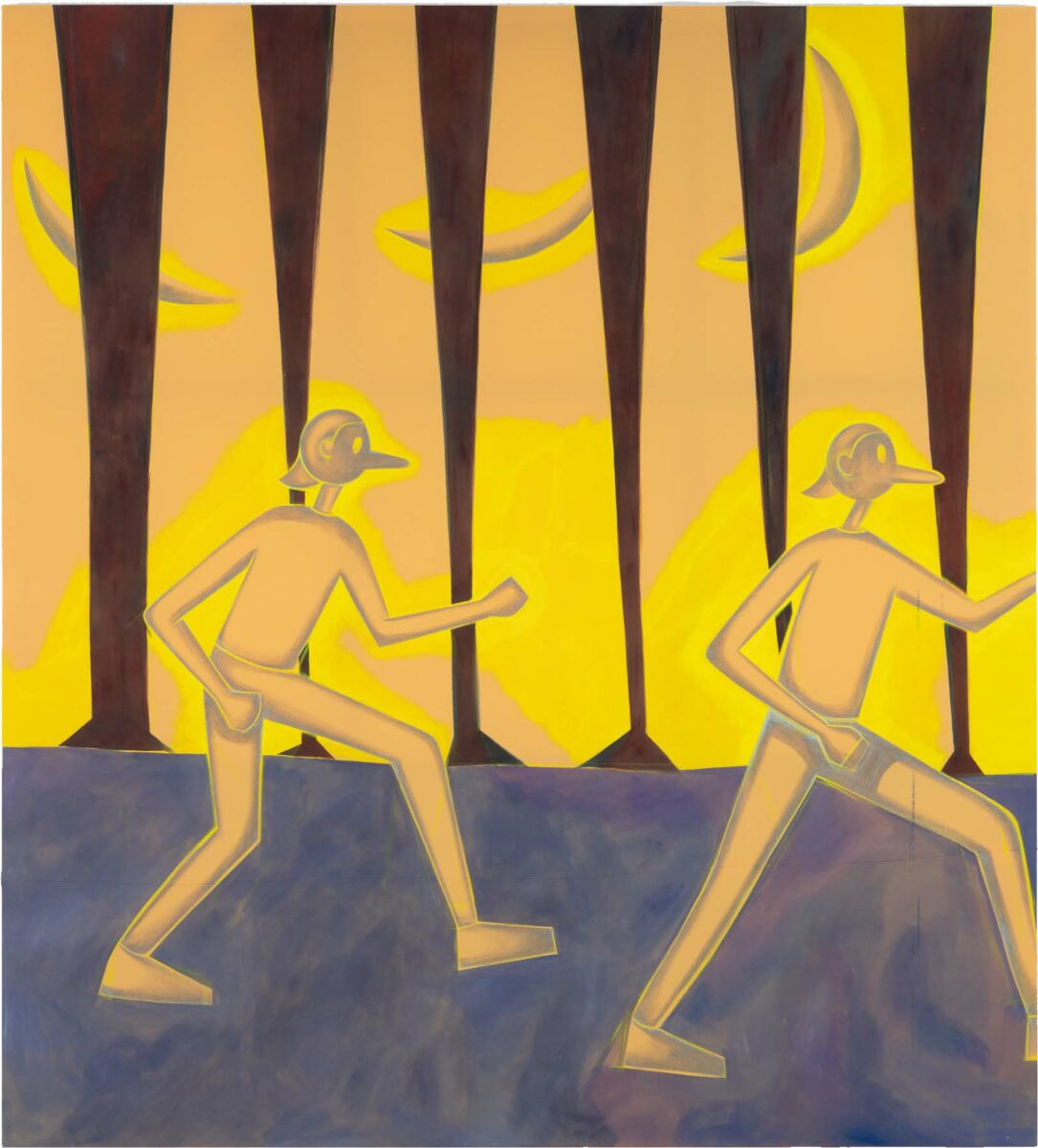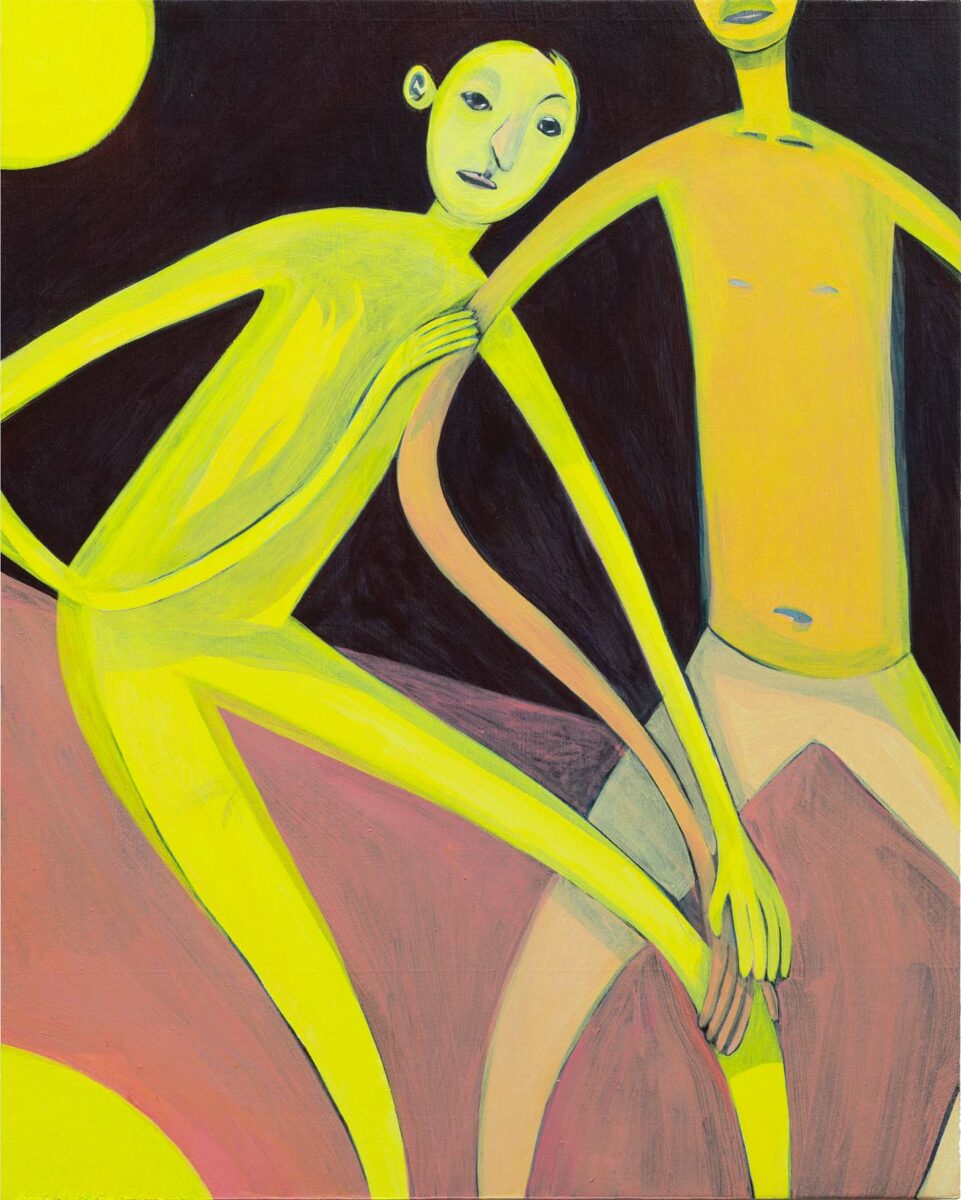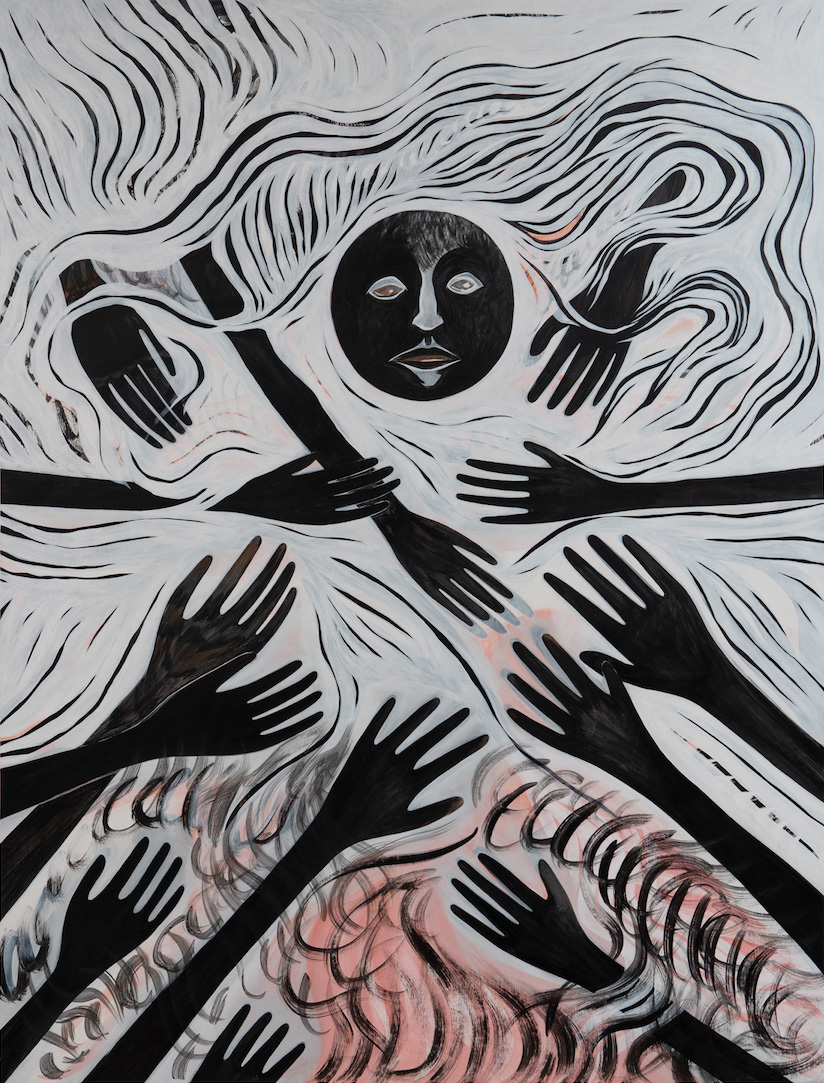Profiles
Jaqueline Cedar on the Magic of Experimentation and Play

Jaqueline Cedar, Nethermead, 10 x 8 x .75 inches, acrylic on panel, 2022.
While I can’t recall when I first happened upon Jaqueline Cedar’s work, I know that once I did, I immediately looked her up and followed her on Instagram. Her figures are instantly recognizable, as are the surfaces she paints on. She stretches her “canvases” with various fabrics like burlap or hot pink spandex – you’d be hard pressed to find a pristine white canvas in her Brooklyn studio. But her exploration doesn’t stop there. Cedar draws, sews fabric sculptures, paints with watercolors, creates etchings, and, while visiting her studio, I sat on more than one piece of furniture that she had hand-painted and redone. We happily met in her air-conditioned apartment/studio this past August and caught back up this month to talk about her practice, where she finds her inspiration, and the importance of “play.”
—Taylor Zakarin
P.s. you can find more of Jaqueline’s work on her website here.
How did you know you wanted to be an artist?
I knew since middle school that I wanted art making and consuming to be a regular part of my life. The first solo drive I took when I got my driver’s license was to LACMA. They had weekly jazz nights and I would wander around sketching the musicians and Rodin sculptures in the garden. As an undergraduate at UCLA I focused on making large scale figurative work. I was consumed by a desire to capture the psychological exchanges evoked through gesture and human connection.
Still living in my hometown, my parents and family became regular subjects in my work. My father and sister – both actors – and mother – gregarious and emotive by nature – were all generous participants in my staged enactments of mannered interactions. By the end of my time at UCLA I had been giving tours at the Hammer Museum and curating small exhibitions of work by peers in the Art Department. I knew that I wanted to keep making work and possibly continue teaching, so I applied and entered grad school at Columbia the following year.
I was 21 when I moved to NYC and I spent most of my time outside the studio at the Met, MoMA, and the Strand bookstore. I followed my classmates around the city learning the gallery scene and building a new understanding of the art world on the opposite coast. It wasn’t until after finishing grad school that I started to understand more practically what it looked like to be a working artist. Soon after finishing my MFA at Columbia I began teaching at the Guggenheim, Whitney, Met, and MoMA. Looking at art and building conversation and community around artists and the ideas they generate has become a significant part of my painting practice. The research I did to prepare for teaching – and later curating – always followed me back to the studio and my individual painting practice. Painting can be quite solitary and I felt lucky to have found related work that provided an opportunity for social exchange.

Jaqueline Cedar, Paper Moon, 66 x 60 inches, acrylic on fabric, 2021
You founded and run Good Naked, a nomadic exhibition program. How do you curate this program?
Good Naked Gallery was a curatorial program that emerged directly out of a newly vacant space – the 2nd bedroom of my Brooklyn apartment. But in fact I had been researching ideas and artists long before the gallery began. As artists, we are often looking to art for inspiration and to place ourselves in context with our peers or with history. I kept a running list of images and artworks I felt connected to. While I primarily make paintings and drawings these days, I have a background in photography and ceramics and, having grown up watching my father perform, a deep love of cinema and theater/dance. So when I began curating I pulled heavily from this compilation of images. I began reaching out to friends in my community – other teaching artists and artist peers whose work I felt deserved more attention. I wanted to make space for new names, ideas, and materials. Six months later, we were forced to quarantine.
I didn’t want to stop programming so I spent a lot of time speaking with other artists about how they’d like their work to be seen considering the circumstances of 2020. We first experimented with virtual programming, creating models of rooms with artwork installed in 3D rendered spaces. Then as it was safe we shifted to outdoor exhibitions in Prospect Park and at a friend’s property in New Hampshire. Eventually it felt safer to travel again and we shifted to a more remote roving outdoor project in Albuquerque, New Mexico at Calendar Gazebo.
As virtual studio visits became normalized I found myself working with several artists who lived outside of NYC and began curating exhibitions in their home cities as a way to start bridging conversations between NY and other art communities. So the program really shifted organically over the past three years to meet the needs of our artists and audience.
I am constantly thinking about the most interesting places and ways to look at art and build conversation with artists, writers, and makers. When the project began in my apartment I wanted to create something like a salon. We hosted play readings, comedy shows, and shared meals. I’m hoping to continue this trajectory moving forward. I like the idea of a program growing to fit the needs of its participants. I am always looking to find new artists and performers to collaborate with. Next month I’ll be working with my father and mother to help produce an art exhibit in relation to his one-man play based on an adaptation of Kafka’s The Trial. I love examining new ways to present art and share ideas.

Jaqueline Cedar, Untitled, 10 x 8 inches, acrylic on panel, 2022
Earlier, you mentioned the problem solving involved with mounting shorter-run pop-up gallery spaces. Any horror stories/amusing anecdotes from past Good Naked iterations?
This ad-hoc way of working definitely increases the potential for moving parts to misalign. We’ve had pretty good luck so far in the way of weather (always a gamble) and we were able to put together a beautiful show in the snow in February 2021. The best part about facilitating pop-up exhibitions frequently is that you start to yield to the rhythm of chaos and last minute planning. This can be quite liberating in the opportunity it provides for chance moves. I try to allow this same kind of urgency and quickness to enter my studio.
Favorite thing about your studio?
It’s quiet, and there’s a good amount of space so I can work on a bunch of paintings at the same time and bounce between them.
It’s clear how willing you are to explore different textures and media in your practice – whether it be using various different fabrics stretched as a canvas, or working with ink, printmaking, colored pencil, among others. Can you talk about this sense of exploration in your work?
I think the most magical part of being an artist is getting the opportunity to experiment and play and discover on a regular basis. At its core, this part of the process is what gets me excited about entering the studio every day. Eventually I settle into a mode of working that I try to bring to fruition in a finished work, but that initial place of wonder is quite alluring.
Much of your work – particularly your large scale painting – is centered around the body in space. And the bodies are immediately recognizable as these particular, mannered figures. How – and/or why – did you come to create this specific style/figure?
This style of figure came out of drawing. In the beginning of my painting practice, I was relying heavily on working from photographs as a reference point for the body. At a certain point after grad school I became increasingly interested in working from memory and dreams, and searching for a photographic reference was slowing me down. I was spending a lot of time on the train commuting to various teaching gigs and began drawing figures from my imagination in transit. I was searching for the quickest way to get at gesture and expression and ended up landing on this stretched out figure. I found that the people in my dreams were using their bodies in ways that weren’t physically possible so my lines stretched to meet their gestures. Eventually I began following this movement and reflecting on the way these longer limbs and noses could direct a viewer’s gaze and add humor to these otherwise existential moments of searching or longing.

Jaqueline Cedar, Dig, 48 x 36 x 1 inches, acrylic on panel, 2022
You’re originally from Los Angeles. Why New York?
New York felt like the next big city to explore. I had lived there for a short stint with my parents as a young child while my father was shooting the PBS kids television show, Square One, so I had some distant memories of the place. When I went to visit I was both overwhelmed and excited by the vastness of the art world.
What does the art world need less of?
Pomp and circumstance.
What does the art world need more of?
Play.
Friends can usually find you…
At Brighton Beach or Prospect Park in the summer. At a museum or theater in the winter.
What is your favorite museum/place to see art in New York?
Hispanic Society of America – pretty magical.
If you weren’t in the art world, what would you do professionally?
Something that involves regular walking and/or ocean swimming. Suggestions welcome!
Any upcoming shows (of your work or part of Good Naked program) we should be looking out for/we can highlight?
Finalizing plans now for some upcoming Good Naked shows this winter in Los Angeles. And preparing for a solo exhibition of my work at The Java Project in NY this spring.